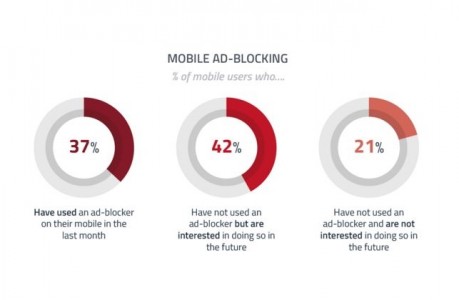Ad Blocking Up 10 per cent in Q4 2015 Due to Mobile
- Tuesday, January 26th, 2016
- Share this article:
 Almost 40 per cent of consumers were using ad blocking tools on their primary computer in Q4 2015, up 10 per cent from the amount using them in Q3, a gigantic bump which was primarily driven by the introduction of ad blocking availability on iOS Safari mobile browser.
Almost 40 per cent of consumers were using ad blocking tools on their primary computer in Q4 2015, up 10 per cent from the amount using them in Q3, a gigantic bump which was primarily driven by the introduction of ad blocking availability on iOS Safari mobile browser.
Between Q3 2014 and Q3 2015, ad blocker use remained fairly consistent, hovering around the 27 per cent mark, according to data from GlobalWebIndex. However, Q4 saw a dramatic increase on this figure, up to 38 per cent.
Focusing just on mobile users, 36 per cent of consumers had used ad blocking tools on their smartphone within the previous month, with 41 per cent saying they had not done this, but were interested in doing so in the future.
As might be expected, younger consumers were at the forefront of this trend, with over 40 per cent of mobile users aged 16-34 saying theyve blocked ads during the last month. This figure falls with each successive age group, but even among 55-64 year olds, 20 per cent had made use of ad blocking technology, demonstrating just how mainstream these tools have become.
Men were more likely to block mobile ads than women (40 per cent compared to 33 per cent), but across economic groups, numbers with fairly consistent. In terms of global regions, ad blocking was most popular in Asia Pacific (45 per cent) and least used in the Latin America (22 per cent).
“A number of factors have combined to cause this rise, from the almost-constant media coverage enjoyed by the subject to the proliferation of free and easily-available tools,” said Jason Mander, director of research and insight at GlobalWebIndex. “But the arrival of ad blocking on mobile has also been encouraging people to adopt this approach across all of their devices.
“Arguably the most striking aspect of this data is the huge potential for ad blocking to continue growing. Across every single age and gender break, its at least 70 per cent who say theyre either blocking ads already or are interested in doing so in the future. Among 55-64s, for example, just 20 per cent might be blocking ads currently, but a further 51 per cent express interest in doing it. That means mobile ad blocking has to be considered a truly cross-demographic behaviour.”
















